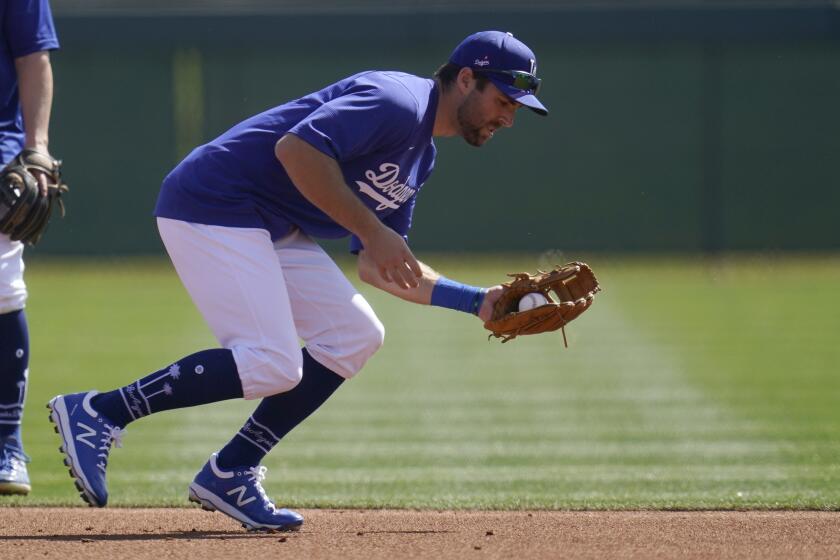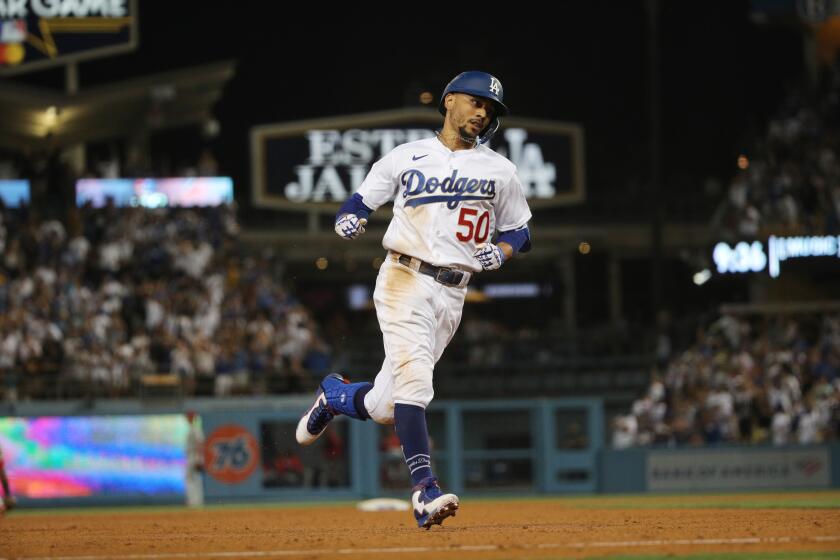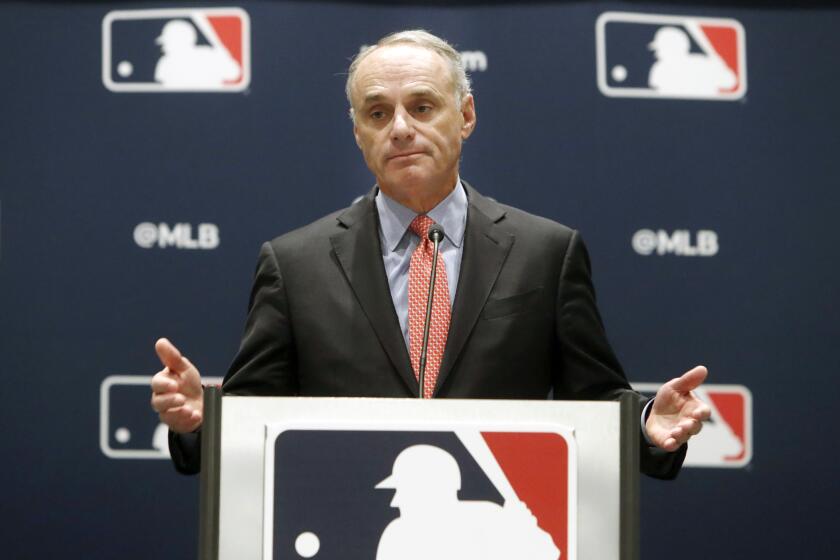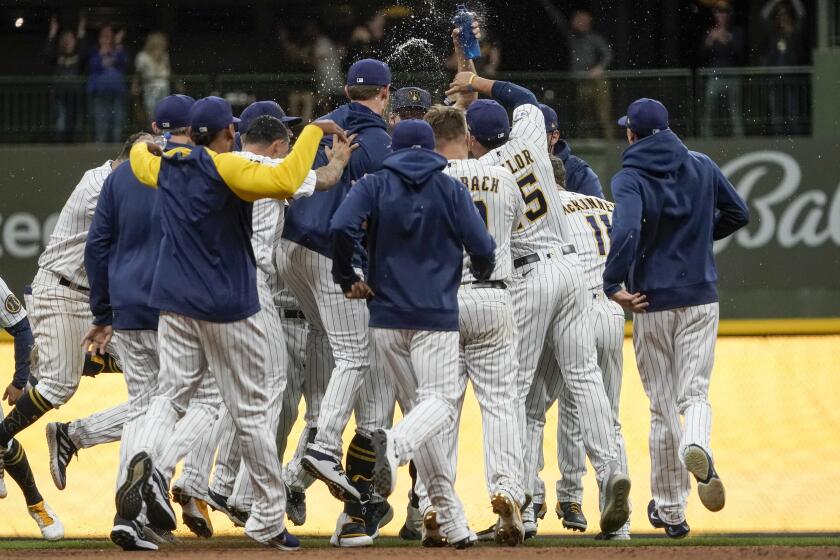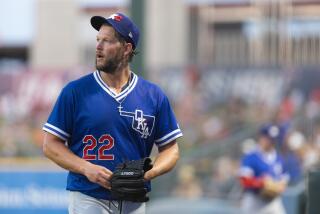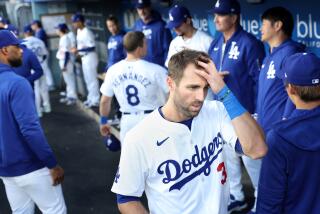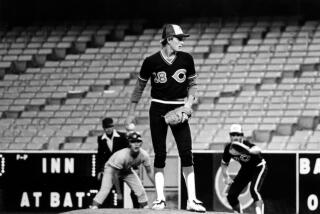He’s the guy the Dodgers traded for Chris Taylor. He hasn’t given up
- Share via
SUMMERLIN, Nev. — Las Vegas Ballpark is not in Las Vegas. The ballpark is in a suburb 10 miles west of the big city. In the distance, you can see the bright lights.
So close, yet so far.
The desert temperature has dipped into the mid-90s as afternoon turns into evening, and a journeyman minor league pitcher offers a handshake. This is his seventh consecutive triple-A season, for six different organizations.
Zach Lee has flecks of gray in his beard. He turns 30 in September. The Dodgers drafted him when he was 18.
As the Dodgers campaign for Chris Taylor to make the All-Star game, Lee’s place in Dodgers lore is secure. He is the guy the Dodgers traded for Taylor. Lee is incredibly gracious about that.
Chris Taylor thought he might have a shot at playing second base every day, but Gavin Lux got that role, leaving Taylor a content super-utility player.
“He’s put himself in a great position. I’m sure a lot of fans, and everyone, is really happy about that,” Lee said. “I’m always happy when a guy like that turns around his career and has success, and can go to the big league level and stay.”
Saturday marks the fifth anniversary of the trade. At the time, the trade between the Dodgers and Seattle Mariners was no big deal, a swap of minor leaguers whose careers had stalled. Taylor had zero home runs in 233 major league at-bats, over parts of three seasons. Lee had one major league start, in which he faced 24 batters and gave up 11 hits.
The trade was reported on Page 5 of the Los Angeles Times’ sports section, in the seventh paragraph of a 10-paragraph story about the Dodgers’ pitching depth.
If there was a big name in the trade, it was Lee. He earned a scholarship to play quarterback at Louisiana State, and he already had arrived on campus in 2010 when the Dodgers persuaded him to ditch football and pitch for a living. They paid him $5.25 million, to this day the largest signing bonus the team has awarded to a draft pick.
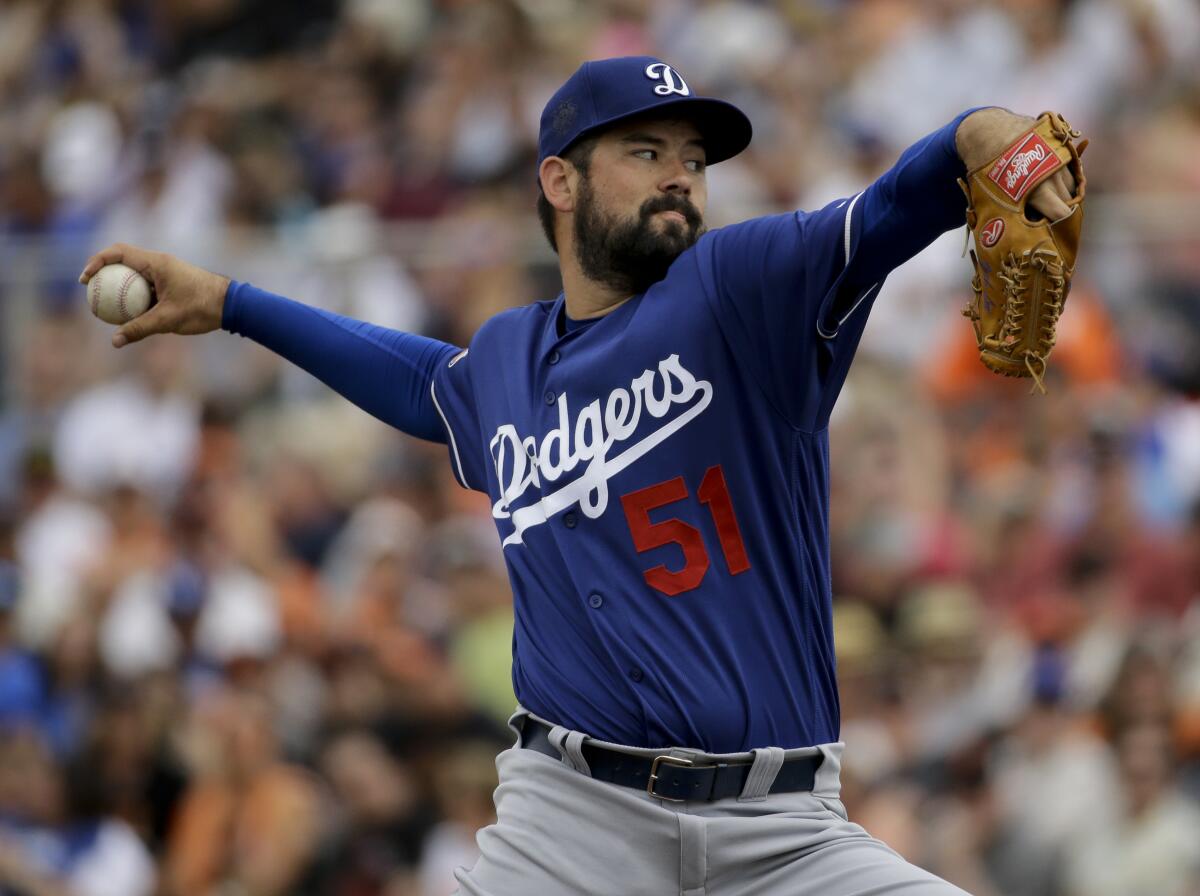
“He just projected really well,” said Logan White, the Dodgers’ scouting director at the time. “You thought you’d get a No. 3 starter in the big leagues, at least.
“At the high end, you’re hoping he’s a [Chris] Carpenter or [Adam] Wainwright, in your dream world. I think most of us thought he would be a [Trevor] Cahill, at least, that type of career.”
Baseball America ranked Lee among its top 100 prospects three times. Taylor never was ranked.
At the time, the trade looked unremarkable. There was little reason to think otherwise.
In 2015, Lee was the Dodgers’ minor league pitcher of the year, honored in a Dodger Stadium ceremony that October alongside the team’s minor league position player of the year, Alex Verdugo, now a fixture in the Boston Red Sox outfield.
In 2016, Ross Stripling beat out Lee for the final spot in the Dodgers’ starting rotation. Stripling took a no-hitter into the eighth inning of his major league debut; Lee went back to triple A. Two months later, he was traded.
White said he is proud of Lee for his persistence and has no regrets about picking him.
“Not everybody turns out as great as you think,” White said. “Some turn out better. The great thing for the Dodgers is, they did a great job getting Chris Taylor for him. So he turned out to be a good selection in that regard.”
Taylor reinvented his swing, under the tutelage of Robert Van Scoyoc, then a Dodgers consultant, now the team’s hitting coach.
Lee, sent to triple A by the Mariners, started 14 games, won none, and posted a 7.39 earned-run average. He said he tried to justify the trade with each appearance, worried that one or two bad ones would doom him.
“The amount of pressure I put on myself doing that really was my downfall,” he said.
The Mariners released him, and the San Diego Padres signed him. They gave him one start, just as the Dodgers had. In this one, he faced 22 batters and gave up two hits. He shut out the Colorado Rockies for 5 1/3 innings, at Coors Field.
Mookie Betts hit a seventh-inning go-ahead homer, lifting the Dodgers to a 5-3 win before a sellout crowd of 52,078 as Dodger Stadium reopened to full capacity.
He earned his first major league victory. That was 50 months ago. He has not started another major league game.
In a baseball world obsessed with velocity, Lee had lost 4-5 mph on his fastball. He never had a serious arm injury.
In retrospect, he believes he understands what happened.
“Taking the football away from me for five years really affected my pitching,” he said.
Not the sport of football. The football itself.
The Dodgers took away the football and directed him to focus on baseball. He does not blame them. What he did not know then, and what all teams did not understand a decade ago, was that pitchers could preserve and enhance velocity by working out with weighted balls.
“Footballs were my weighted balls,” Lee said.
On the day after he pitched, Lee said he liked to long toss with footballs, “where I’m not taxing my arm in the same spots from the day before.”
He visited the renowned Driveline pitching facility last winter, more for biomechanical evaluation than for its weighted-ball program that pitchers and teams have embraced as a way to improve velocity.
“Doing a run and gun with a 10-ounce ball? I can see both sides of it,” Lee said. “Yes, you’re going to increase your velocity over time, if your body doesn’t break down. For me, the football, I feel, can accomplish that for myself, while also being a much safer environment, because of my background.
“I grew up throwing 200 footballs a day and then going out and pitching seven innings. My body knows that stress and how to adjust to it, how to acclimate itself to it. If I go out and throw a 1,000-gram ball 80 times into a wall, my body is probably going to go, ‘What are we doing?’ ”
MLB pitchers caught using illegal substances to doctor balls will be ejected and suspended 10 games in a crackdown starting Monday.
In his last full year with the Dodgers, the one in which they honored him as their minor league pitcher of the year, Lee said triple-A pitching coach Scott Radinsky encouraged him to work out with the football. Since then, he said, some organizations have been supportive, others less so, concerned about teammates turning an ankle while running routes to catch his throws, or pretending to play defensive back.
The Arizona Diamondbacks, his current employers, have allowed him to prepare in whatever way he prefers. By doing it his way, he hopes to increase his velocity to a consistent 92-94 mph by the end of the season, then see what opportunities might await.
“You control what you can control, which is your performance on the field and your attitude off of it,” he said.
Lee already has started taking online classes toward a business degree. He could complete his degree on campus, and on a college football team.
“I might be a 30-year-old walk-on,” he said, “but why not? There’s no reason not to, even if I’m sitting there holding a clipboard for a little while. Having a mature older guy around some of those guys probably wouldn’t be a bad idea in general. If you get an opportunity and things go well, who knows what happens?
Major League Baseball is again using the runner-at-second rule to start extra innings. Several other ideas have been considered.
“To me, if I’m going back to school full-time and I’m not playing baseball, there’s no harm in trying.”
Taylor said he “absolutely” is rooting for Lee, and for any other player so close, yet so far, for so long.
“From everything I’ve heard from guys over here, he’s an awesome dude,” Taylor said. “I hope he has success.”
For now, the trade ranks as one of the most lopsided of the 21st century, with Taylor a World Series champion and National League Championship Series most valuable player.
Who was the guy the Dodgers traded to get Taylor? Lee could be best remembered as the answer to a trivia question.
“Very well could be,” Lee said. “Regardless of the trade, most of the time, there’s one side that benefits more than the other.”
He smiled. He was not offended. He also was not giving up.
“I’m still trying to continue to build and hopefully get an opportunity where I can do what he did, and turn myself around once I get that next opportunity,” Lee said.
“If I can get up there and stay, and have a three- or four-year career, that trivia question may change a little. It may not be the first thing you think of when you hear my name.”
More to Read
Are you a true-blue fan?
Get our Dodgers Dugout newsletter for insights, news and much more.
You may occasionally receive promotional content from the Los Angeles Times.

